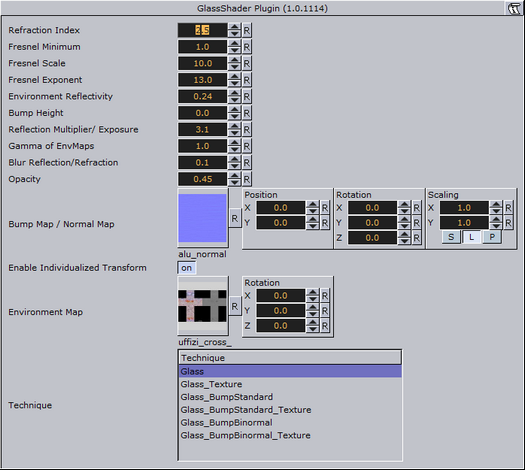
Viz Artist
Version 3.10 | Published May 03, 2018 ©
Glass Shader
![]()
Apart from the parameters in the plug-in container, it is necessary to assign a texture as a color/basic texture and a material. Do not forget to adjust material parameters in addition, such as ambient, diffuse, specular color and shininess, to achieve the required look for your surface.
Both refraction and reflection are taken from the surrounding (from a cube map) and are blended to create the dielectric effect of glass. In addition, lighting by a highlight and a color texture are used to describe the material in detail. The opacity of the object can be controlled to modulate between the solidly lit surface and the transparent impression of glass.

Note: This plug-in is located in: Built Ins -> Shader -> RTTAdvancedMaterials
This section contains information on the following topics:
Glass Shader Properties

-
Refraction Index: Controls the refraction index of the material, and accordingly the strength of the refraction.
-
Fresnel Minimum, Fresnel Scale and Fresnel Exponent: Affects the Fresnel effect upon the reflection.
-
Environment Reflectivity: Manipulates the influence of the reflection color from the environment map on the resulting color.
-
Bump Height: Manipulates the height of the created bumps on the surface.
-
Reflection Multiplier/Exposure: Affects the exposure of the environment map.
-
Gamma of EnvMaps: Controls the gamma correction of the environment map. This is particularly helpful when working with HDR images.
-
Blur Reflection: States to which extent the environment reflection and refraction are blurred to create the impression of a rougher surface.
-
Opacity: Influences the mixing of the solid material color and the dielectric glass effect (reflection and refraction).
-
Bump Map/Normal Map: Is the texture that defines the surface structure with encoded normals.
-
Environment Map: Is a cube map that describes the environmental surrounding used to calculate reflections and refractions.
-
Technique: Shows a list of available techniques.
-
Glass: Is a technique to be used for plain glass.
-
Glass_Texture: Is a technique to mix a diffuse texture color into the material color.
-
Glass_BumpStandard: Is a technique to create bump mapping with the given normal map on the surface of the geometry that has no standard UV texture coordinates and normals.
-
Glass_BumpStandard_Texture: Is a technique to use a diffuse color texture and bump mapping on the surface of the geometry that has no texture coordinates and normals.
-
Glass_BumpBinormal: Is a technique to create bump mapping for geometry with texture coordinates and normals.
-
Glass_BumpBinormal_Texture: Is a technique to use a diffuse color texture and bump mapping on the surface of geometry with texture coordinates and normals.
-
Glass Shader Best Practices
Apart from the parameters in the plug-in container, it is necessary to assign a material and a texture as a color/basic texture. Do not forget to adjust material parameters in addition, such as ambient, diffuse, specular color and shininess, to achieve the required look for your surface.